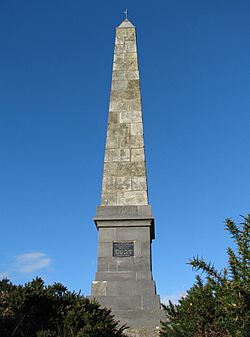Battle of Three Rocks facts for kids
Quick facts for kids Battle of Three Rocks |
|||||||
|---|---|---|---|---|---|---|---|
| Part of the Irish Rebellion | |||||||
 Monument at the site of the battle. Erected in 1952. |
|||||||
|
|||||||
| Belligerents | |||||||
| Commanders and leaders | |||||||
| Thomas Cloney Robert Carty John Kelly Michael Furlong |
Captain Adams Lieutenant Birch |
||||||
| Strength | |||||||
| 1,000–2,000 | 100 | ||||||
| Casualties and losses | |||||||
| Unknown | 70 dead, 18 captured | ||||||
The Battle of Three Rocks was an important fight during the Irish Rebellion of 1798. It was a big win for the United Irishmen, who were Irish rebels fighting against British rule. They defeated a group of British soldiers and their cannons who were trying to help the town of Wexford. This battle happened on May 30, 1798, near Forth Mountain in County Wexford.
Contents
Why the Battle Happened: The Background
By May 29th, the Irish rebels had won battles at Oulart Hill and Enniscorthy. These wins helped the rebellion spread across County Wexford. Rebel groups set up camps in many places. This trapped British troops in a few towns like Wexford, Gorey, and Bunclody/Newtownbarry. These towns were now open to attack.
British Plans to Reinforce Wexford
General Fawcett was the British commander at Duncannon fort. When he heard about the rebel victories, he led 200 soldiers to help the British troops in Wexford town. He also ordered another group of about 100 soldiers and gunners to follow. This second group had two large cannons called howitzers. They were supposed to meet Fawcett's soldiers halfway between Wexford and Duncannon, in a village called Taghmon.
General Fawcett's soldiers moved quickly and reached Taghmon by evening. They stayed the night in the village. The slower cannon group arrived at Taghmon after 2 AM. But for some reason, they kept going towards Wexford. It seems that people who supported the rebels might have tricked them. They might have been told that the road to Wexford was clear and that they needed to hurry.
How the Rebels Prepared for Battle
The reports given to the British cannon group were false. A large group of rebels from South Wexford had gathered on Forth Mountain. They knew the British soldiers were coming. The rebels set up a surprise attack spot at the eastern end of Forth Mountain, in an area called the "Three Rocks."
Setting the Trap
In the dark before dawn, rebel soldiers with muskets hid behind rocks and bushes. They were placed along the path where the British were expected to march. Hundreds of other rebels, armed with long spears called pikes, waited out of sight. Rebel signalers used flags to watch the roads. They waited for the British troops to walk into their trap.
As dawn arrived, the British soldiers marched right into the trap without knowing. The rebels fired their muskets from close range. Then, many pikemen charged forward. The British soldiers had no chance to get organized. The fight was over in just a few minutes. About 70 British soldiers were killed. Most of the gunners were captured, and the rebels took control of the two howitzer cannons.
British Retreat and Wexford's Fall
A few British soldiers who escaped the battle reached General Fawcett's force in Taghmon about an hour later. They told him about the disaster. General Fawcett was worried because his support group was destroyed. He also feared that the rebels now had cannons. So, he ordered his men to go back to Duncannon. This meant he gave up his plan to help Wexford.
Wexford Garrison's Reaction
Meanwhile, General Maxwell, who commanded the British soldiers in Wexford, was worried. The troops from Duncannon had not arrived, and he heard about fighting. He led a group of cavalry (soldiers on horseback) towards the Three Rocks to meet the expected help. They soon saw the United Irishmen moving the captured cannons to use against Wexford. General Maxwell's cavalry quickly rode back to town. However, they lost a cavalry captain to rebel gunfire before they escaped.
Wexford Falls to the Rebels
The retreat of the cavalry, the news of the defeat at Three Rocks, and the thought of facing rebels with cannons made the British soldiers in Wexford lose hope. They also saw many more rebels gathering north of Wexford bridge. So, they sent people to talk to the approaching rebels and ask for peace.
The British soldiers left Wexford town before the United Irishmen entered. The rebels freed prisoners, including Bagenal Harvey. They also set up a new government called the Committee of Public Safety, similar to one in France. They even organized a small navy to protect the harbor. Any British military people or important loyalists who could not escape were quickly rounded up. They were held in the town jail, on a prison ship, or in other makeshift prisons.
The United Irishmen now controlled almost all of County Wexford. They were in a strong position to attack the few remaining British groups in the county, such as those at Bunclody, Gorey, and New Ross.

